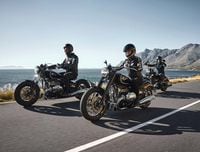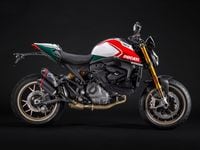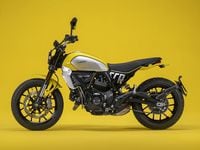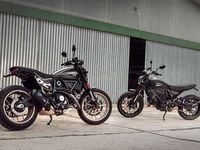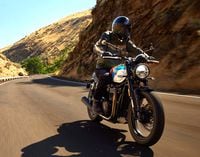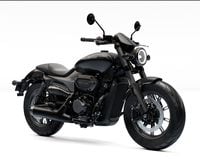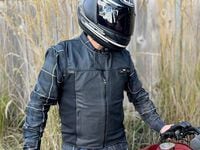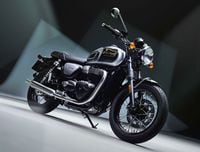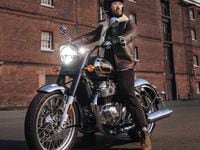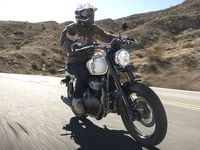Occasionally, fate tosses you a curveball. If you let it pass, chances are things will remain pretty much the same. But if you take a swing at it, your life may change direction in a heartbeat. Case in point: Jim Guffin and his VTX 1800.
One Saturday morning, Mr. Guffin, an inveterate gearhead who grew up immersed in the Southern California motor culture, decided to take a toot in his 1931 Ford Tudor hot rod. Unfortunately, fate decreed otherwisethe rod's magneto packed it in and his ride was canceled on the spot. Jim was torqued; the motor gods had thrown a sizeable monkey wrench into his plans.
Now at this point, Jim was a former rider who hadn't been on a motorcycle in 20 years, but being understandably exasperated with his hot rod, he needed some sort of outlet before he blew a gasket. Surmising that a new bike might just do the trick, he went shopping, returning home 12 hours later with a brand-new '02 VTX 1800. Now that the wheels of fate were set in motion, they began to turn, slowly at first but inexorably.
Initially the bike was kept more or less stock. The problem was that Jim, scion of a serious powerboat-racing father, was genetically disinclined toward leaving anything stock for very long. After three months of tooling around on a VTX that was just like everyone else's, Jim decided it was time to start modifying the thing. Like most of us, he started by adding some eye candy and bolting on a few accessories while he kept the bike on the road. He soon grew frustrated with the piecemeal approach and realized that the only way to build what he really wanted was to start with a clean sheet of paper, a pile of aluminum billet and some sharp tool bits.
Being both talented and pragmatic, the first thing he did was put together a fully equipped home machine shop. Then, as he puts it, "I sat my ass down in front of the bike and started cutting templates. [My goal was] to make things simple and functional." Working within broad parameters, Jim knew he wanted two things from the project. First, a standout bike built mainly with one-off pieces, preferably ones he made himself. Secondly, a solid, high-performance machine that was practical to use on an everyday basis. Once he knew what he wanted he let out the clutch.
He began with some simple engine upgrades. A Dynojet PC3 and a set of Vance & Hines Big Shots were hung on the VTX mill as starting points. With fuel and exhaust-management issues resolved, Jim turned his attention toward the air cleaner. An off-the-shelf item was out of the question; no offense, but how many fake supercharger scoops do we really need? What he wanted was something no one else had. Starting with hunks of 6061-T6 aluminum, he began carving. When all the chips had hit the floor he'd created an efficient plenum chamber with dual velocity stacks. Besides looking good and flowing more air than the stock airbox, his "V2 intake" hid all the sensors required to run the VTX's fuel injection, and incorporated the crankcase vent, a water-drainage port and a K&N; panel filter. With the PC3, the pipes and Jim's airbox, the bike made 99.8 horsepower on the dyno. Respectable, perhaps, but not nearly enough for a dedicated go-faster.
The solution was simple in theory but a bit more complex in execution. Rather than build a bigger or more radical engine—a complicated and expensive route at best, especially when you consider that there were only a few VTX performance parts available at the time—Jim decided to bolt on the juice. Yep, that's right. Nitrous it. Unfortunately, there were no bolt-on kits available. So Jim had to roll his own from parts, and fabricate the ones he couldn't buy. With the nitrous installed, horsepower at WFO runs right around 130. Since the system is only activated at wide-open throttle, around-town driveability and overall reliability remain stock.
Now that the motor made some serious grunt, Jim turned his attention toward the chassis and suspension. A Fat Fork kit from Kewlmetal dressed up the front end's appearance. Fat Fork also supplied the flamed fork guards. Since the Fat Forks made the stock top clamp look a little skimpy, Jim whittled a stylish finishing piece that also houses the cable guides. To firm up handling, the soggy OEM fork springs were replaced by a pair from Progressive Suspension. With the front end cleaned up, the rat's nest of brake hoses located under the lower clamp stood out like a sore thumb. After a few hours on the milling machine a new billet manifold replaced Honda's linked brake system, complete with stainless-steel lines. No more sore thumbs. Since the stock calipers were more than capable of dealing with the bike's velocity, they were returned to duty after being chromed. The rear rotor is the standard VTX unit; the front rotors are by RC Components.
Jim collaborated with Viking Motorcycle to develop the trick, air-adjustable rear suspension, the aptly named "Sinnister" Air Ride. The air suspension varies the shock height from 111/4 inches right down to a pavement-hugging 91/4 inches. This allows the bike to be ridden normally at speed but slammed for profiling. The compressor is hidden under the swingarm, and the controls are easily reachable from the saddle, allowing the rider to adjust the suspension on the fly. As a finishing touch the shocks feature adjustable compression and rebound damping.
To get all that laughing-gas-enhanced power to the pavement requires a man-size rear skin. Jim decided that a 240/40X18 rear would work fine. As long as he built a swingarm to accommodate it, it sounds simple enough, doesn't it? With input from the guys at Honda Direct Line, the swingarm design was finalized, tooled, milled, TIG-welded, smoothed and chromed before being hung in the stock frame. Simple it wasn't, but the end result was well worth it. Of course the wide rear tire and swingarm demanded a new rear fender. While designing and fabricating a wide fender would appear to be a straightforward job, the fact is that it took Jim and friend Paul Mott of Xtreme Revolution three months to develop. To smooth the look of the rear end the fender mounts outside the factory frame rails. Paul then CNC-machined new fender support struts to tie the whole thing together.
Reinstalling the stock hoops was out of the question. Accordingly, a set of RC components wheels were installed, along with a pair of Metzeler ME 880 tires, the aforementioned 240/40X18 rear and a 130/70X21 front. The modified VTX now sticks to the road like a nailed-on toupee.
With the running gear finalized, Jim turned his thoughts and talents toward some of the more prosaic items. The fuel tank went to painter Joe Nieman in Lakewood, Colorado. Joe filled and decked the tank before shooting it with House of Kolor's Kandy Brandywine over a gold base. He also laid on the flames and painted the rest of the bike. The seat, a one-off custom, was built by Corbin. The side covers were another Xtreme Revolution item. The sleek front fender was created by Jim, who also built the brackets. To achieve the close fit he wanted, Jim placed aquarium tubing between the front tire and fender. He kept reducing the gap between the fender and tire until the thin tubing was compressed by half before he finalized the bracket dimensions.
In his spare time Jim and his milling machine chewed out a bunch of small but vital items. The Maltese Cross rear brake-fluid reservoir, for example, and the license-plate mount are both examples of Jim's handiwork. The forward controls were built with the help of Jim's good friend and master machinist Ken Oliver.
When Jim couldn't or realistically didn't have the time to fabricate certain items, he turned to those who could. Jim convinced the guys at Baron to build the handlebars. They agreed, but only if Jim offered up suggestions on the speedometer mount. The one-off driving lights and forward running lights use Kuryakyn LED and halogen lamps.
After six months of cutting, grinding, polishing and cussing, the VTX, now a radically different bike, was back on the road. It was faster, handled better and had the meticulous detailing that made it an instant show winner. That's not just smokethe bike was shown for the first time at the Great American Motorcycle Show held in Atlanta, Georgia, where it took home the Best Metric Custom Award.
In the end Jim's hot-rod VTX was everything he hoped it would become and then some. That being the case, who could blame him if he claimed all the credit? But Jim is the first to point out that he couldn't, and didn't, do it alone. "The bike was a collective, collaborative effort by lots of guys within the VTX community. All I did was bring them together."
Resources
Baron Custom Accessories
www.baronscustom.com
(888) 278-2819
Corbin
www.corbin.com
(800) 538-7035
Dynojet
www.dynojet.com
(800) 992-4993
Honda Direct Line
www.hondadirectline.com
(888) 258-6699
Kewlmetal
www.kewlmetal.com
(562) 695-3599
Kuryakyn
www.kuryakyn.com
(800) 843-7896
Metzeler
www.metzelermoto.com
(706) 368-5826
RC Components
www.rccomponents.com
(888) 721-6495
Street Muscle Painting
http://coloradorider.com/joe/streetmuscle.htm
(303) 886-9493
Vance & Hines
www.vanceandhines.com
(800) 592-2529
Viking Motorcycle
www.vikingmotorcycle.com
(877) 743-3862
Xtreme Revolution
www.xtremerevolution.com
(858) 566-5788
For more articles on custom bikes and articles about how to customize and modify your motorcycle, see the Custom section of MotorcycleCruiser.com.










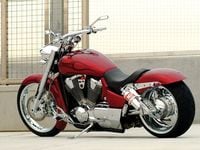
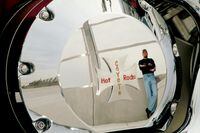
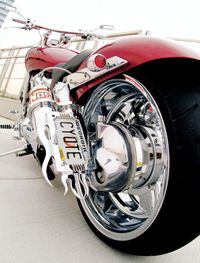
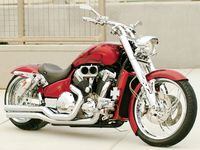
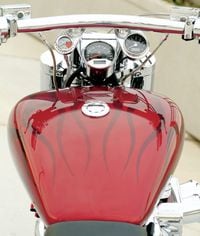
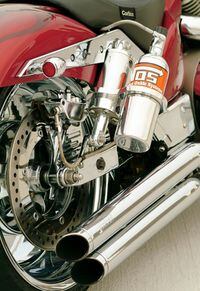
/cloudfront-us-east-1.images.arcpublishing.com/octane/H6Z2IC7WYRBXZNQS4MI3SZ5KPQ.jpg)
/cloudfront-us-east-1.images.arcpublishing.com/octane/IWO5T5PBT5E4HFQ5GK47H5YXR4.jpg)
/cloudfront-us-east-1.images.arcpublishing.com/octane/OQVCJOABCFC5NBEF2KIGRCV3XA.jpg)
/cloudfront-us-east-1.images.arcpublishing.com/octane/F3O2DGLA4ZBDJGNVV6T2IUTWK4.jpg)
/cloudfront-us-east-1.images.arcpublishing.com/octane/ZXYQE3MHLFDSPKNGWL7ER5WJ4U.jpg)
/cloudfront-us-east-1.images.arcpublishing.com/octane/RDF24VM7WVCOBPIR3V3R4KS63U.jpg)
/cloudfront-us-east-1.images.arcpublishing.com/octane/W7RSIBFISNHJLIJESSWTEBTZRQ.jpg)
/cloudfront-us-east-1.images.arcpublishing.com/octane/AERA26ENRNBW3K324YWCPEXYKM.jpg)
/cloudfront-us-east-1.images.arcpublishing.com/octane/YWX3YX7QBBHFXFDMEEEKRG4XJE.jpg)
/cloudfront-us-east-1.images.arcpublishing.com/octane/I7OKI53SZNDOBD2QPXV5VW4AR4.jpg)
/cloudfront-us-east-1.images.arcpublishing.com/octane/IH52EK3ZYZEDRD3HI3QAYOQOQY.jpg)
/cloudfront-us-east-1.images.arcpublishing.com/octane/K2FSAN7OWNAXRJBY32DMVINA44.jpg)
/cloudfront-us-east-1.images.arcpublishing.com/octane/G4XK7JL24FCUTKLZWUFVXOSOGE.jpg)
/cloudfront-us-east-1.images.arcpublishing.com/octane/JJNXVAC27ZCDDCMTHTQZTHO55Y.jpg)
